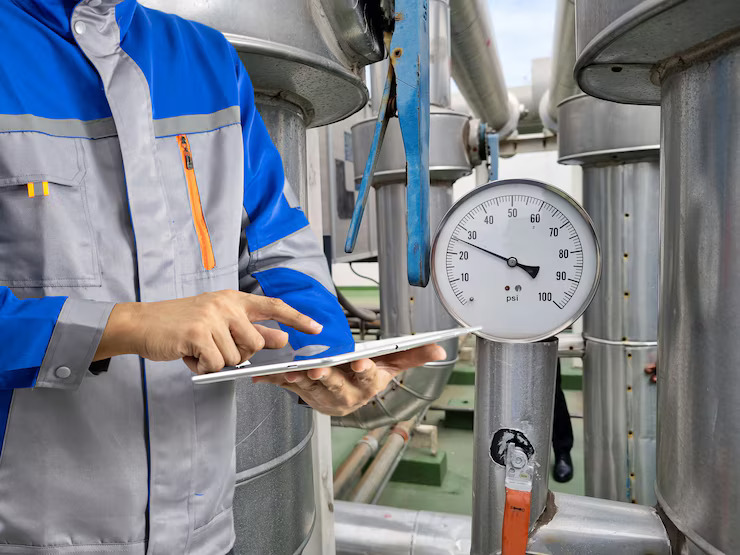In industrial processes where precision is crucial, turbine flow meter calibration are widely used for their accuracy, reliability, and repeatability in measuring fluid flow. However, like any measurement instrument, their performance can degrade over time due to factors such as wear, contamination, or changes in process conditions. That’s where calibration plays a vital role.
Turbine flow meter calibration is the process of verifying and adjusting the flow meter’s performance to ensure it provides accurate and traceable measurements. This article explores how turbine flow meters work, why calibration is important, how it’s performed, and best practices for maintaining measurement integrity.
What is a Turbine Flow Meter?
A turbine flow meter measures the volumetric flow rate of liquids or gases. It operates based on the mechanical principle that fluid flowing through the meter causes a multi-bladed rotor (turbine) to spin. The rotational speed of the turbine is directly proportional to the flow rate.
Key components include:
- Rotor: Spins with the flow of fluid.
- Housing: Contains and directs the fluid through the rotor.
- Pickup Sensor: Detects the rotation and translates it into electrical signals for measurement.
Turbine flow meters are widely used in industries such as:
- Oil and gas
- Water and wastewater treatment
- Chemical processing
- Food and beverage
- Pharmaceuticals
Why Calibration is Critical
Over time, various factors can affect the performance of a turbine flow meter:
- Wear and tear on the rotor blades
- Viscosity changes in the fluid
- Temperature or pressure variations
- Contamination or debris buildup
As a result, the readings can drift from their true value, leading to errors in critical measurements. Regular calibration ensures:
- Measurement accuracy
- Regulatory compliance
- Process efficiency
- Cost savings by avoiding over- or under-measurement
- Traceability to national or international standards
Calibration vs. Verification
It’s important to distinguish between calibration and verification:
- Calibration involves comparing the meter’s readings against a known standard and adjusting the meter if discrepancies are found.
- Verification simply checks if the readings are within acceptable limits without making any adjustments.
In regulated industries, calibration is required at defined intervals to comply with ISO, FDA, or other quality systems.
How Turbine Flow Meter Calibration Works
Calibration of turbine flow meters typically takes place in a controlled environment, either in a calibration laboratory or at the process site (field calibration). The process involves several key steps:
1. Setup and Preparation
- The flow meter is installed in a calibration rig that simulates real operating conditions.
- The fluid used for calibration (usually water or oil) is chosen based on the application.
2. Reference Standard
- A reference flow measurement device (like a master meter or gravimetric system) with known accuracy is used for comparison.
3. Flow Rate Testing
- The fluid is passed through both the reference device and the turbine flow meter at multiple flow rates.
- Readings are recorded at each point and compared.
4. Data Analysis
- The output of the turbine meter is compared to the reference values.
- A calibration factor or K-factor (pulses per unit volume) is determined.
- If deviations exceed acceptable tolerances, adjustments or recalibration is performed.
5. Documentation
- A calibration certificate is issued, detailing the calibration conditions, results, traceability, and adjustments made.
Calibration Standards and Frequency
Turbine flow meter calibration should be performed according to industry standards such as:
- ISO/IEC 17025 (general requirements for calibration laboratories)
- API MPMS (Measurement standards for petroleum and natural gas)
- NIST-traceable calibration for U.S.-based measurements
Calibration Frequency Depends On:
- Application criticality
- Operating conditions
- Manufacturer recommendations
- Regulatory requirements
In general, annual calibration is recommended, though critical processes may require more frequent calibration.
Field vs. Laboratory Calibration
Laboratory Calibration:
- Offers high precision in a controlled environment
- Ideal for high-accuracy applications
- Requires removing the flow meter from service
Field Calibration:
- Performed onsite using portable calibrators
- Suitable for non-critical or continuous-process applications
- Quicker and less disruptive
Both methods are valid, but the choice depends on accuracy needs, process downtime tolerance, and budget.
Common Calibration Errors to Avoid
- Incorrect installation: Flow meter should be installed in a straight run with minimal turbulence.
- Air bubbles or cavitation: Can cause erratic readings.
- Improper reference device: Always use a certified and traceable standard.
- Environmental inconsistency: Temperature and pressure should match real operating conditions.
Working with accredited calibration providers ensures that these variables are properly controlled and documented.
Benefits of Regular Calibration
- Improved product quality
- Enhanced operational efficiency
- Reduced downtime and maintenance costs
- Regulatory and audit compliance
- Reliable billing and reporting in utility and commercial applications
In industries where precision matters, inaccurate flow data can lead to financial losses, product defects, or even safety hazards. Regular calibration mitigates these risks.
Conclusion
Turbine flow meter calibration is an essential practice for ensuring accurate and reliable flow measurement in various industrial applications. It not only maintains the integrity of the process but also helps meet regulatory and quality standards. By understanding the calibration process and adhering to scheduled maintenance, industries can ensure their flow meters continue to perform with the accuracy needed to drive productivity and performance.


